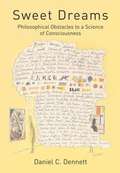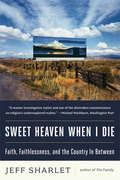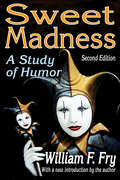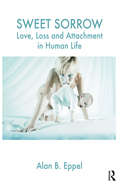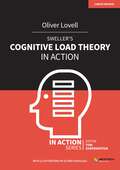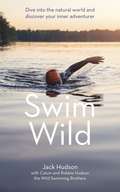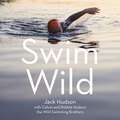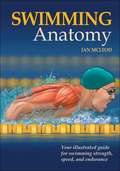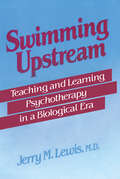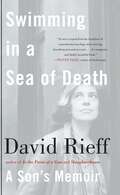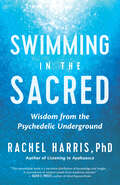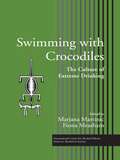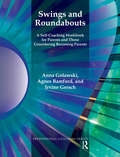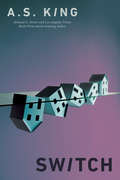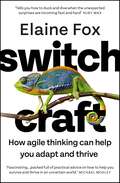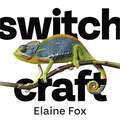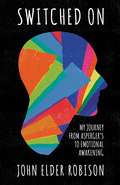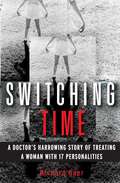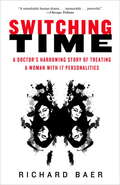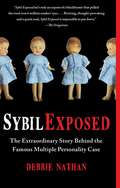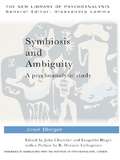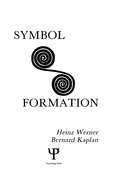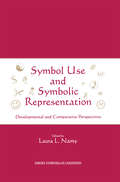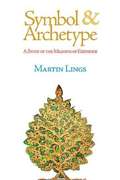- Table View
- List View
Sweet Dreams: Philosophical Obstacles to a Science of Consciousness
by Daniel C. DennettSweet Dreams is a collection of essays and lectures written between 1999 and 2005 in which Dennett tries to freeze time and present a 'best' version of his evolving ideas...
Sweet Heaven When I Die: Faith, Faithlessness, and the Country In Between
by Jeff Sharlet"A master investigative stylist and one of the shrewdest commentators on religion's underexplored realms."--Michael Washburn, Washington Post In this gorgeous collection of essays that has drawn comparisons to the work of Joan Didion, John McPhee, and Norman Mailer, best-selling author Jeff Sharlet reports back from the far reaches of belief, whether in the clear mountain air of "Sweet Fuck All, Colorado" or in a midnight congregation of anarchists celebrating a victory over police. Like movements in a complex piece of music, Sharlet's dispatches vibrate with all the madness and beauty, the melancholy and aspirations for transcendence, of American life.
Sweet Madness: A Study of Humor (Paperbounds Ser. #No. Pb-3)
by William FryWritten for all who are interested in the mechanics of humor, Sweet Madness presents a general discussion and introduction to the roles of paradox, metaphor, and fantasy in humor. The operation of the implicit and the unconscious in humor; the importance of humor to human life; and the development, from childhood on, of the sense of humor are discussed.The background for this serious study is drawn from such fields as psychiatry, psychology, anthropology, and sociology. William F. Fry, in this work, presents a new theory of the structure of humor based on the sometimes little understood psychological processes experienced by those who use humor or are exposed to humor. It is these relationships with other fields of study that allows for this investigation into the anatomy of humor.Fry, in this outstanding and erudite volume, takes a giant step in furthering our thinking about humor in transactional terms. Humor and a sense of humor are a vital part of human interactions, and as such, this book has much to contribute to the study of psychology, cultural, communications, and of coursehumor itself.
Sweet Sorrow: Love, Loss and Attachment in Human Life
by Alan B. EppelThis book defines the centrality of love and loss in human life and in human meaning. Bowlby's Attachment theory forms the basis for understanding our selves and our relationships. The author proposes that love is the subjective experience of attachment and that dyadic relationships are the source of ultimate meaning. He supports his theses with a tour de force integration of ideas from attachment theory, psychoanalysis, neuroscience and existential philosophy. He argues that the quality of attachment between mother and infant lays the foundation for the formation of individual identity and ultimately shapes our capacity to engage in relationships with others. The author describes loss as the reciprocal of attachment and considers the enormous influence of loss on our moods, sense of identity, and our desire to live or die. The final segments of the book describe the implications of this analysis and links it to the meaning and purpose of human life. All of us seek to understand the meaning of life, and especially the meaning of our own lives.
Sweller's Cognitive Load Theory in Action (In Action)
by Tom Sherrington Oliver LovellWhat is it that enables students to learn from some classroom activities, yet leaves them totally confused by others? Although we can't see directly into students' minds, we do have Cognitive Load Theory, and this is the next best thing. Built on the foundation of all learning, the human memory system, Cognitive Load Theory details the exact actions that teachers can take to maximise student outcomes.Written under the guidance, and thoroughly reviewed by the originator of CLT, John Sweller, this practical guide summarises over 30 years of research in this field into clear and easily understandable terms. This book features both a thorough discussion of the core principles of CLT and a wide array of classroom-ready strategies to apply it to art, music, history, chemistry, PE, mathematics, computer science, economics, biology, and more.
Sweller's Cognitive Load Theory in Action (In Action)
by Tom Sherrington Oliver LovellWhat is it that enables students to learn from some classroom activities, yet leaves them totally confused by others? Although we can't see directly into students' minds, we do have Cognitive Load Theory, and this is the next best thing. Built on the foundation of all learning, the human memory system, Cognitive Load Theory details the exact actions that teachers can take to maximise student outcomes.Written under the guidance, and thoroughly reviewed by the originator of CLT, John Sweller, this practical guide summarises over 30 years of research in this field into clear and easily understandable terms. This book features both a thorough discussion of the core principles of CLT and a wide array of classroom-ready strategies to apply it to art, music, history, chemistry, PE, mathematics, computer science, economics, biology, and more.
Swim Wild: Dive into the natural world and discover your inner adventurer
by Jack Hudson Calum Hudson Robbie HudsonLive a more creative, content and fulfilled life by reconnecting with nature.Brothers Jack, Calum and Robbie have been swimming together their whole lives, and have never lost the sense of wonder, excitement and relief that getting in open water brings. In this book, we learn about their swimming feats, from tackling the 145km River Eden to setting the world record for swimming in the Arctic. They take us through their preparation for these expeditions, including sourcing wild spots in the heart of sprawling cities in which to train. They document the challenges they encounter and the successes often achieved in the most unexpected ways. And with everything they've learned, they give tips for those wanting to take on their own aquatic foray, whether a beginner or a seasoned swimmer. This book will show people of all ages how they too can take part in open water swimming and reconnect with the natural world around them.Their experience will embolden readers to escape their status quo and build confidence and contentment by challenging themselves to try something new and reconsider their relationship with nature and the wild. At its core, this book will provide advice, reassurance and inspiration for anyone in search of something more joyful, peaceful and, ultimately, meaningful.
Swim Wild: Dive into the natural world and discover your inner adventurer
by Jack Hudson Calum Hudson Robbie HudsonHow to live a more creative, content and fulfilled life by reconnecting with nature.Brothers Jack, Calum and Robbie have been swimming together their whole lives, and have never lost the sense of wonder, excitement and relief that getting in open water brings. In this book, we learn about their swimming feats, from tackling the 145km River Eden to setting the world record for swimming in the Arctic. They take us through their preparation for these expeditions, including sourcing wild spots in the heart of sprawling cities in which to train. They document the challenges they encounter and the successes often achieved in the most unexpected ways. And with everything they've learned, they give tips for those wanting to take on their own aquatic foray, whether a beginner or a seasoned swimmer.This book will show people of all ages how they too can take part in open water swimming and reconnect with the natural world around them.Their experience will embolden readers to escape their status quo and build confidence and contentment by challenging themselves to try something new and reconsider their relationship with nature and the wild. At its core, this book will provide advice, reassurance and inspiration for anyone in search of something more joyful, peaceful and, ultimately, meaningful.(P)2018 Hodder & Stoughton Limited
Swimming Anatomy (Anatomy)
by Ian McLeodSwimming Anatomy includes 74 of the most effective swimming exercises, each with step-by-step descriptions and full-color anatomical illustrations highlighting the primary muscles in action. Swimming Anatomy goes beyond exercises by placing you on the starting block, in the water, and into the throes of competition. Illustrations of the active muscles for starts, turns, and the four competitive strokes (freestyle, breaststroke, butterfly, and backstroke) show you how each exercise is fundamentally linked to swimming performance. You'll also learn how exercises can be modified to target specific areas, improve your form in the water, and minimize common swimming injuries. Best of all, you'll learn how to put it all together to develop a training program based on your individual needs and goals. Whether you are training for a 50-meter freestyle race or the open-water stage of a triathlon, Swimming Anatomy will ensure you enter the water prepared to achieve every performance goal.
Swimming Upstream: Teaching and Learning Psychotherapy in a Biological Era
by Jerry M. LewisFirst published in 1991. The experiential base from which this book is written the author’s seminar for psychiatric residents which emphasizes that self-disclosure with colleagues is an important aspect of becoming a therapist. The ability to look at and listen to one's own work along with one's peers is important in the maturation process. In order to construct a context in which it is possible to learn from each other, I share many of my own psychotherapeutic experiences. More than this, however, Lewis shares personal experiences when they seem appropriate to the teaching-learning process.
Swimming in a Sea of Death: A Son's Memoir
by David RieffBoth a memoir and an investigation, Swimming in a Sea of Death is David Rieff's loving tribute to his mother, the writer Susan Sontag, and her final battle with cancer. Rieff's brave, passionate, and unsparing witness of the last nine months of her life, from her initial diagnosis to her death, is both an intensely personal portrait of the relationship between a mother and a son, and a reflection on what it is like to try to help someone gravely ill in her fight to go on living and, when the time comes, to die with dignity. Rieff offers no easy answers. Instead, his intensely personal book is a meditation on what it means to confront death in our culture. In his most profound work, this brilliant writer confronts the blunt feelings of the survivor -- the guilt, the self-questioning, the sense of not having done enough. And he tries to understand what it means to desire so desperately, as his mother did to the end of her life, to try almost anything in order to go on living. Drawing on his mother's heroic struggle, paying tribute to her doctors' ingenuity and faithfulness, and determined to tell what happened to them all, Swimming in a Sea of Death subtly draws wider lessons that will be of value to others when they find themselves in the same situation.
Swimming in the Sacred: Wisdom from the Psychedelic Underground
by Rachel HarrisWISDOM FROM THE WOMEN HEALERS OF THE PSYCHEDELIC UNDERGROUND The use of entheogens, or psychedelics, is out of the closet today. LSD, psilocybin, MDMA, and other medicines once associated only with the counterculture are now being legally studied for their healing properties. But as Rachel Harris shows, the underground use and study of psychedelics by women dates back to the Eleusinian Mysteries of ancient Greece. Harris interviews the modern women elders carrying on this tradition to gather their hard-won wisdom of experience. Any reader interested in inspiration, healing, and enlightenment will find here a wonder-filled narrative packed with provocative and perhaps life-changing insight.
Swimming with Crocodiles: The Culture of Extreme Drinking (ICAP Series on Alcohol in Society)
by Fiona Measham Marjana MartinicThere is evidence that a distinct pattern of alcohol consumption is emerging across the world and is a cause for concern because of its relationship with a range of health and social problems. Its visibility, particularly its high involvement of young people, makes this not only an issue for public safety and order in many countries, but also a highly contentious and politicized subject. This book examines the rapid and heavy drinking behavior by young people, described in a number of countries, positioning it within its appropriate social, historical and cultural contexts. The book argues in favor of a new term, “extreme drinking,” to fully encapsulate the many facets of this behavior, taking into account the underlying motivations for the heavy, excessive and unrestrained drinking patterns of many young people. It also acknowledges the drinking process itself and accommodates greater focus on outcomes that are likely to follow. In many ways, “extreme drinking” is not so far removed from other “extreme” behaviors, such as extreme sports – all offer a challenge, their pursuit is motivated by an expectation of pleasure, and they are, by design, not without risk to those who engage in them, others around them and society as a whole. Edited by Marjana Martinic and Fiona Measham, Swimming with Crocodiles is the ninth volume in the ICAP Book Series on Alcohol in Society. The authors discuss the factors that motivate extreme drinking, address the developmental, cultural and historical contexts that have surrounded it, and offer a new approach to addressing this behavior through prevention and policy. The centerpiece of the book is a series of focus groups conducted with young people in Brazil, China, Italy, Nigeria, Russia, South Africa, and the United Kingdom, which examine their views on extreme drinking, motivations behind it and the cultural similarities and differences that exist, conferring at once risk and protective factors.
Swings and Roundabouts: A Self-Coaching Workbook for Parents and Those Considering Becoming Parents (The\professional Coaching Ser.)
by Anna Golawski Agnes Bamford Professor Irvine GerschThe first two authors of this coaching workbook are themselves parents who have been on a journey of "swings and roundabouts" - experienced the highs and lows of having children. Having difficulties knowing how to parent in many situations, which was not made easier by the conflicting advice in the media, made them unsure of their own parenting skills. This was one of the reasons that they entered into the field of parent-coaching. They were trained coaches who wanted to use their coaching skills and experience as parents to help both themselves and other parents get the understanding and trust in themselves to be the parents they dream of being. As an educational and child psychologist, Irvine was able to contribute an evidence and psychological base to the project.Parents often feel alone and the authors have found that running courses for them created a space where they could share experiences with each other as well as experiment with different ways of parenting. It is their intention to give back some of the awareness they gained in this comprehensive and invaluable self-coaching book.
Switch
by A.S. KingA surreal and timely novel about the effects of isolation and what it means to be connected to the world from the Printz Award-winning author of Dig.Time has stopped. It's been June 23, 2020 for nearly a year as far as anyone can tell. Frantic adults demand teenagers focus on finding practical solutions to the worldwide crisis. Not everyone is on board though. Javelin-throwing prodigy Truda Becker is pretty sure her "Solution Time" class won't solve the world's problems, but she does have a few ideas what might. Truda lives in a house with a switch that no one ever touches, a switch her father protects every day by nailing it into hundreds of progressively larger boxes. But Truda's got a crow bar, and one way or another, she's going to see what happens when she flips the switch.
Switchcraft: Harnessing the Power of Mental Agility to Transform Your Life
by Elaine FoxWhat is the key ingredient to a happy, successful life?There is no one-size-fits-all solution to dealing with life. Elaine Fox, one of the world's leading psychologists and performance coaches, has witnessed this time and again. In her work coaching top athletes, military leaders and business professionals, she has seen that it's the people who know how and when to switch between different approaches - people who have an agile mind - who achieve the best performance.Drawing on 25 years of scientific research, Fox shares with us her step-by-step guide to what she calls 'switchcraft': the set of skills we need to navigate a complex and uncertain world. Whether it's coping with a difficult boss, overcoming a fear, dealing with hyperactive children, resolving a dispute with a friend or making a difficult choice about where to live or what to do, switchcraft helps us thrive in any situation.Like your own personal life coach, Switchcraft shows you how to break out of a rigid mindset to restore your fulfilment, curiosity and zest for life.
Switchcraft: How Agile Thinking Can Help You Adapt and Thrive
by Elaine FoxA revolutionary audiobook on the power of mental agility to transform your life, from Oxford psychologist and neuroscientist Professor Elaine Fox.What is the key ingredient to a happy, successful life?Endless self-help approaches claim to have the answer. It's important to be mindful, we are told, and to stay in the moment. Sometimes, we are advised to keep going no matter what, to be 'gritty'. Others tell us that adopting a growth mindset' is key. However, the truth is that there is no one size fits all solution to dealing with life. Elaine Fox, one of the world's leading psychologists and performance coaches, has witnessed this time and again. In her work coaching top athletes, military leaders and business professionals, she has seen that it's the people who know how and when to switch between different approaches - people who have an agile mind - who achieve the best performance.Drawing on 25 years of scientific research, Fox shares with us her step-by-step guide to what she calls 'switchcraft': the set of skills we need to navigate a complex and uncertain world. Whether it's coping with a difficult boss, overcoming a fear, dealing with hyperactive children, resolving a dispute with a friend or making a difficult choice about where to live or what to do, switchcraft helps us thrive in any situation.Like your own personal life coach, Switchcraft shows you how to break out of a rigid mindset to restore your fulfilment, curiosity and zest for life.(P) 2022 Hodder & Stoughton Limited
Switched On: From Asperger's to Emotional Awakening
by John Elder Robison"For the first time in my life, I learned what it was really like to truly "know" other people's feelings. At a stroke I went from oblivious to insightful, and my life was forever changed. It was as if I'd been experiencing the world in black and white all my life, and suddenly I could see everything - and particularly other people - in brilliant beautiful color."Six years ago, John Elder Robison published Look Me In the Eye, his memoir about growing up with Asperger's. Now he tells the remarkable story of how he met Dr Alvaro Pascual-Leone, a Harvard neuroscientist who proposed that John's emotional intelligence wasn't so much absent as it was dormant, and that by animating the appropriate neural pathways with powerful electromagnets he might be able to awaken this part of his brain. So began a five-and-a-half year journey in which John gave himself up as a guinea pig to some of the world's top brain researchers in an effort to understand and fix the deficits of emotional intelligence that lie at the heart of autism.John experiences the benefits and pitfalls, the joy and melancholy, of being able to feel in response to things that happen to him and his loved ones. A real-life Flowers For Algernon with a happy ending, Switched On goes on the trail of the revolutionary science that has the potential to transform millions of emotionally circumscribed lives.
Switching Time: A Doctor's Harrowing Story of Treating a Woman with 17 Personalities
by Richard K. BaerIn 1989, Karen Overhill walks into psychiatrist Richard Baer's office complaining of vague physical pains and depression. Odder still, she reveals that she's suffering from a persistent memory problem. Routinely, she "loses" parts of her day, finding herself in places she doesn't remember going to or being told about conversations she doesn't remember having. Her problems are so pervasive that she often feels like an impersonator in her own life; she doesn't recognize the people who call themselves her friends, and she can't even remember being intimate with her own husband. Baer recognizes that Karen is on the verge of suicide and, while trying various medications to keep her alive, attempts to discover the root cause of her strange complaints. It's the work of months, and then years, to gain Karen's trust and learn the true extent of the trauma buried in her past. What she eventually reveals is nearly beyond belief, a narrative of a childhood spent grappling with unimaginable horror. How has Karen survived with even a tenuous grasp on sanity? Under hypnosis, alternate Karen personalities reveal themselves in shocking variety and with undeniable traits - both physical and psychological. One "alter" is a young boy filled with frightening aggression; another an adult male who considers himself Karen's protector; and a third a sassy flirt who seeks dominance over the others. It's only by compartmentalizing her pain, guilt, and fear in this fashion-by "switching time" with alternate selves as the situation warrants - that Karen has been able to function since childhood. Realizing that his patient represents an extreme case of multiple personality disorder, Baer faces the daunting task of creating a therapy that will make Karen whole again. Somehow, in fact, he must gain the trust of each of Karen's seventeen "alters" and convince them of the necessity of their own annihilation. As powerful as Sybil or The Three Faces of Eve, Switching Time is the first complete account of such therapy to be told from the perspective of the treating physician, a devoted healer who worked selflessly for decades so that Karen could one day live as a single human being. This book includes grim and disturbing, though not grisly descriptions of child abuse. It also contains language that is objectionable to many people.
Switching Time: A Doctor's Harrowing Story of Treating a Woman with 17 Personalities (Playaway Adult Nonfiction Ser.)
by Richard K. BaerBaer, now medical director for the nation's largest Medicare contractor, had a psychiatry practice for 14 years. He offers a complete account of his 18 year odyssey with Karen Overhill, a seemingly normal wife and mother who came to him for depression and eventually revealed 17 separate personalities. A classic case of multiple personality disorder (MPD), Karen survived a childhood of unimaginable horror and was only able to maintain even a tenuous grasp on sanity with the help of 16 alters who lived inside her--men, women, and children, each frozen at a certain age and stage in Karen's development. Baer draws on 622 pages of progress notes, videos and audiotapes of sessions, and Karen's journal entries and letters to describe their journey into the human psyche. B&w letters and drawings are included, along with an epilogue by Karen herself. Annotation ©2007 Book News, Inc. , Portland, OR (booknews. com)
Sybil Exposed: The Extraordinary Story Behind the Famous Multiple Personality Case
by Debbie NathanNow available in paperback, Sybil Exposed is the New York Times bestselling book that offers a new perspective on the smash hit book and film, Sybil, and on multiple personality disorder itself. Sybil: a name that resonates with legions of obsessed fans who followed the nonfiction blockbuster from 1973. The book rocketed multiple personality disorder into public consciousness and played a major role in having the diagnosis added to the psychiatric bible, Diagnostic and Statistical Manual of Mental Disorders. But what do we really know about how Sybil came to be? In her news-breaking book Sybil Exposed, journalist Debbie Nathan gives proof that the allegedly true story outlined in the megabestseller was largely fabricated. The actual identity of Sybil (Shirley Mason) has been available for some years, as has the idea that the book might have been exaggerated. But Nathan reveals the trio of women behind the legend: the willing patient, her ambitious shrink, and the imaginative journalist who spun their story into bestseller gold. Sybil Exposed draws from an enormous trail of papers, records, photos, and tapes to unearth the lives and passions of these three women whose story exploded into an epic movement with consequences beyond their wildest dreams. Set across the twentieth century and rooted in a time when few professional roles were available to women, this is a story of corrosive sexism, bold but unchecked ambition, runaway greed, utter human vulnerability, duplicity and shared delusion, shaky theories of psychoanalysis exuberantly and drastically practiced, and how one modest young woman’s life turned psychiatry on its head and radically changed the course of therapy—and our culture, as well.
Symbiosis and Ambiguity: A Psychoanalytic Study (The New Library of Psychoanalysis)
by José BlegerSymbiosis and Ambiguity is the first English edition of the classic study of early object relations by influential Argentinian psychoanalyst José Bleger (1922-1972). It is rooted in Kleinian thinking and rich in clinical material. Bleger's thesis is that starting from primitive undifferentiation, prior to the paranoid-schizoid position described by Klein, autism and symbiosis co-exist as narcissistic relations in a syncretic ‘agglutinated’ nucleus. In symbiosis part of the mind is deposited in an external person or situation; in autism it is deposited in the patient's own mind or body. The nucleus is ambiguous and persists in adults as the psychotic part of the personality. Symbiosis tends to immobilise the analytic process, so the analyst must mobilise, fragment and discriminate the agglutinated nucleus, whose ambiguity tends to ‘blunt’ persecutory situations. The psychoanalytic setting functions as a silent refuge for the psychotic part of the personality, where it creates a ‘phantom world’. At some point, therefore, the setting itself has to be analysed and the analytic relationship de-symbiotised, as Bleger observes in a celebrated chapter on the setting. José Bleger’s work demonstrates the need to analyse early narcissistic object relations as they arise clinically, especially in the setting. More widely, he regards undifferentiation and participation as operating throughout life: in groups, institutions, and society as a whole.
Symbol Formation
by H. Werner B. KaplanFirst published in 1984. The authors’ basic aim in this volume has been to set forth a certain perspective on psychological phenomena and to show how this perspective enables one to order and integrate data on symbolization and language behavior—data obtained by a variety of methods and garnered from domains that are too often treated in isolation from each other.
Symbol Use and Symbolic Representation: Developmental and Comparative Perspectives (Emory Cognition Project)
by Laura L. NamySymbol Use and Symbolic Representation: Developmental and Comparative Perspectives is the proceedings of a workshop held at Emory University in 2002 to discuss the difficult and age-old issue of what makes a symbol symbolic. The issue shifts towards exploring the relation between apparent symbolic behavior and actual symbolic insight on the part of the user or recipient.The workshop discussed the pitfalls of inferring symbolic understanding from apparently symbolic behaviors and possible criteria that would enable us to ascertain when a symbol is being employed in an intentional, communicative, representational manner. Broken down into three parts, this volume:*focuses on the factors that influence the emergence of symbolic behavior in young, typically developing children;*turns to an examination of individual and population differences in symbolic development and the ways variability in symbol use can inform the cognitive mechanisms underlying symbolic insight; and*explores symbolic understanding in non-human animals. The text ends with a synthesis of recurring themes, questions, concerns, and conclusions, and offers a new perspective on the process of understanding the relation between symbol use and symbolic insight.
Symbol and Archetype: A Study of the Meaning of Existence
by Martin LingsEvery religious tradition or metaphysical worldview involves a system of powerful symbols, most of which bear common meanings across cultures, continents, and time. This volume, complete with a 9th century Quranic manuscript, explores the significance of the most recurrent symbols and archetypes in human history and elaborates a compelling theory for why symbolism plays such an essential role in human life. The work explores certain basic aspects of symbolism in relation to the Divinity, the hierarchy of the universe, the function of human faculties and qualities, the human condition, natural objects, works of art, and the final end--all with reference to the great living religions of the world, and in particular to Christianity and Islam.
